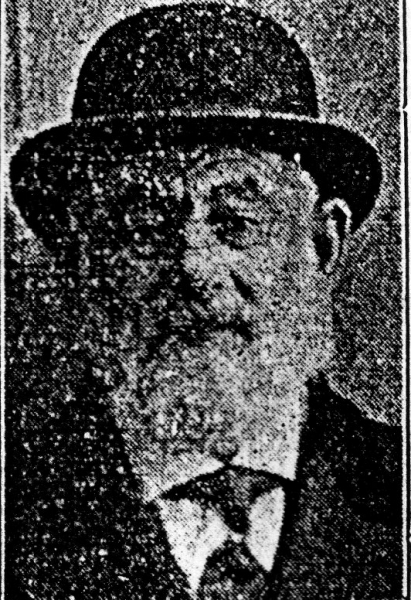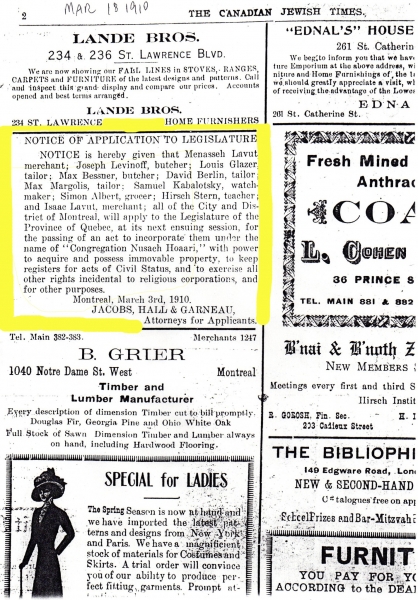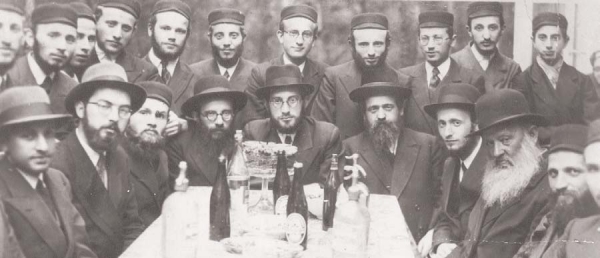Nosach Ha'ari
1914 - 1962
100 Ave des Pins E.
Historic outline
Nosach Ha’ari is often referred to as Nosach Ha’ari South to distinguish it from a synagogue by the same name on Jeanne Mance, was established in the 1920s at 100 Pine Ave. Famously, this synagogue served as the first house of worship of a group of Lubavitch Jews who arrived in Montreal during World War II.
Lubavitch (or Chabad) Hasidism was founded in 1773 in Russia by Shneur Zalman of Liadi. Unlike other Hasidic groups that focus on an emotional experience of God, the Lubavitch emphasize a more intellectual approach to worship. They also stand out for their active outreach activities, through which they seek to lead secular Jews to Orthodox practice. In Montreal, the Lubavitch community was originally associated with Menashe Lavut, a Russian immigrant from the town of Nikolaev who came to Canada in 1905. Around 1910, Lavut founded the Anshei Chabad Lubavitch group, as well as the Beys Medresh Nusach Ha’Ari synagogue and study hall.
The Lubavitch were among the first Hasidic groups in Montreal. Yet while the city is now home to a sizable Hasidic population, the major influx of Hasidic Jews dates only to the end of the Second World War. Indeed, it was not until 1941 that Montreal’s Lubavitch community saw significant growth, prompted by the arrival of nine students fleeing the Nazi regime and the war in Europe. Most were from the Tomchei Temimim yeshiva in Otwock, a suburb of Warsaw, Poland. The students managed to obtain visas to immigrate to Japan, and eventually came to Canada via Shanghai in 1941. It was an exceptional event in the wartime context, when Jewish immigration to Canada was all but shut down. Readers of the Yiddish press eagerly awaited the young Jews, and the Yiddish newspaper Der Keneder Adler gave their arrival special coverage, reporting on the various steps in their journey from Shanghai to Montreal.
The nine students decided to provide their Lubavitch group with a separate yeshiva, promptly opening it in the basement of the Nusach Ha’Ari synagogue on Pine Avenue. Its launch marked the start of the more official development of the Lubavitch community. With some twenty-five students in its first year, the synagogue went on to welcome two hundred the next. In 1943, the institution moved to a new building on Park Avenue. Known today as the Rabbinical College of Canada or Yeshivas Tomchei Temimim Lubavitch , it is currently located on Westbury in the Côte-des-Neiges district of Montreal.
The building on Pine was sold in the 70s to a French theatre group, Theatre de Quat’ Sous. The theatre company made little changes to the building other than installing a stage in what was probably the former space of the aron hakodesh, until finally demolishing the building in 2005, erecting a modern theatre.
Physical description
The building, originally three residential units, was renovated to accommodate the synagogue. The second floor was modified to form a women’s gallery. The far left doorway, on the north-west corner of the building, was used as the entrance to the synagogue. Due to the configuration of the building, the aron hakodesh was not located on the wall opposite the entrance, which was the norm, but on the side wall to the left of the doorway which was the eastern wall, thus orienting the synagogue towards the prescribed direction of prayer.
By Valérie Beauchemin and Sara Tauben.
Links
Liens
Rabbi Kramer's LegacyTHE FORGOTTEN HASIDIM: RABBIS AND REBBES IN PREWAR CANADA
Sources
Lapidus, Steven, The Forgotten Hassidim: Rabbis and Rebbes in Prewar Canada, Revue Canadian Jewish Studies/Études juives canadiennes 12 : 1-30, 2004. Print
Shaffir, William, Life in a Religious Community: The Lubavitcher Hassidim in Montreal, Toronto, Holt, Éditions Rinehart and Winston of Canada Limited, 1974. Print.
Tauben, Sara Ferdman. "Aspirations and Adaptations: Immigrant Synagogues of Montreal, 1880s-1945." Masters Thesis. Concordia University, 2004.
Tauben, Sara Ferdman. Traces of the Past: Montreal's Early Synagogues. Montréal: Véhicule Press, 2011.
Weinfeld, Shaffir and Irwin Cotler. The Canadian Jewish Mosaic, Rexdale, Éditions John Wiley & Sons, 1981. Print.
* Images courtesy of Neil Folberg, Dr. Steven Lapidus, and www.rabbikramerslegacy.com


This project is funded in part by the Government of Canada.
Ce projet est financé en partie par le gouvernement du Canada.
Ce projet est financé en partie par le gouvernement du Canada.
This project is funded in part by the Government of Canada.
© 2011-2015 Museum of Jewish Montreal, All Rights Reserved.
Site by Air Code Design inc. ![]()
© 2011-2015 Musée du Montréal Juïf, Tous droits réservés. Site par Air Code Design inc. ![]()





